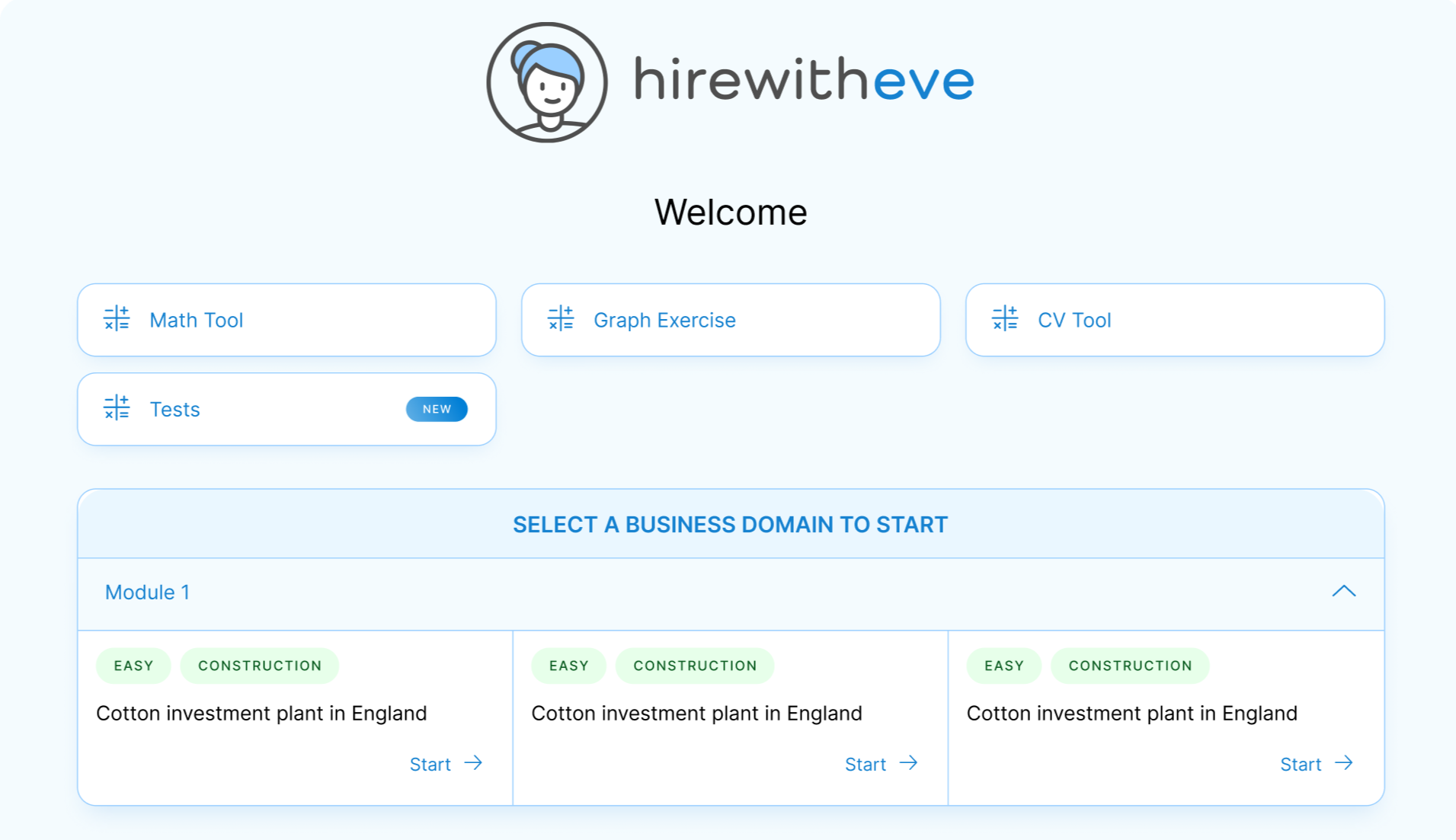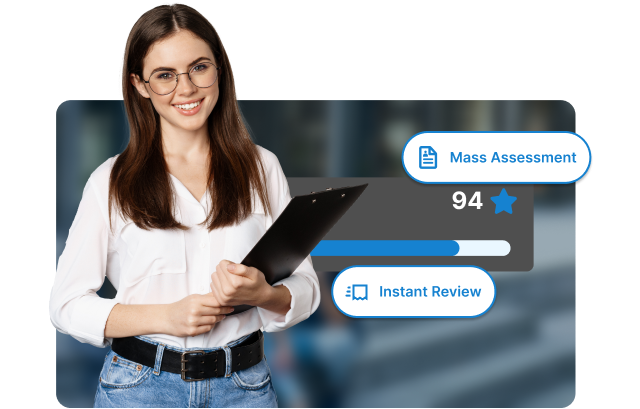Enhancing Learning Agility in the Workplace

In today's rapidly changing business landscape, the ability to adapt and learn continuously is more important than ever. As your company evolves and focuses on new niches, the challenges faced by your employees will also change. Even if they have excellent communication skills and passed all skill tests during the hiring process, some may struggle to keep up. This often boils down to a lack of learning agility.
Learning agility is defined as the ability to quickly pick up new knowledge and skills and apply them effectively in different situations. It involves being comfortable with change, thriving on new challenges, and continuously seeking opportunities for learning and development.
This blog will explore the concept of learning agility, why it is crucial for your organization, and how to measure and develop it within your workforce. We will also discuss how HirewithEve can be the ideal software solution for your talent assessment needs, helping you build a team that can navigate the complexities of the modern business environment.
Table of contents
The Importance of Learning Agility in the Workplace
What Does Learning Agility Look Like in Different Roles and Industries?
How to Measure Learning Agility in the Workplace: Methods and Techniques
Utilizing HirewithEve to Enhance Learning Agility Assessments
How to Foster Learning Agility in Your Workforce
Learning Agility FAQs
Conclusion
The Importance of Learning Agility in the Workplace
Experts agree that the ability to adapt and learn quickly is essential for both individual and organizational success. Michael Lombardo and Robert Eichinger, renowned for their work on learning agility, emphasized the need to measure an individual's potential to learn new competencies to perform under novel, tough, or different conditions. The Korn Ferry organization further breaks down learning agility into five key factors: mental agility, change agility, people agility, results agility, and self-awareness.
Key Factors of Learning Agility
Mental Agility: This involves thinking critically, gathering information quickly, and applying knowledge to real-life scenarios. Mentally agile individuals embrace complexity and excel at analyzing situations.
Change Agility: Learning-agile people are curious, experimental, and ambitious. They approach change with a positive attitude and are excited about experimenting with new ideas and processes.
People Agility: These individuals show high emotional intelligence, are open-minded, and build healthy relationships. They bring out the best in others and foster a collaborative work environment.
Results Agility: Learning-agile professionals are results-oriented and work effectively even under pressure. They thrive on achieving positive outcomes despite challenges and obstacles.
Self-awareness: Highly self-aware individuals understand their strengths and weaknesses and adapt well to challenging situations. They value feedback and use it to improve continuously.
Why Learning Agility Matters
Learning agility contributes to higher performance, better talent management, reduced employee turnover, and more flexible processes. It helps organizations stay competitive by promoting creativity, resilience, and inspiring leadership.
According to LinkedIn's 2023 Workplace Learning Report, the average skill set has changed by 25% since 2015, highlighting the importance of continuously developing new skills.
Without agile workers, companies risk stagnation. To stay ahead, organizations must hire and develop employees who can adapt to changing market conditions, embrace new strategies, and prioritize continuous learning.
What Does Learning Agility Look Like in Different Roles and Industries?
Learning agility manifests differently across various roles and industries. Let's explore how it plays out in a few key sectors.
Web Design and Content Production
The web design industry is heavily influenced by changes in search engine algorithms. For instance, Google's focus on "Helpful Content" requires SEO managers, content writers, and programmers to constantly adapt to new priorities and metrics. Learning-agile professionals in this field can quickly pivot strategies to ensure their content remains relevant and high-ranking.
Finance and Banking
The finance industry, especially during the COVID-19 pandemic, saw a significant shift towards digitization. Employees in this sector must be technologically savvy and quick to adapt to new tools and platforms. Learning-agile professionals can support customers with technical issues, upsell new products, and provide financial advice that caters to evolving needs.
Logistics and Delivery
The logistics and delivery industry operates at a fast pace, driven by consumer demands for quick and accurate deliveries. Learning-agile workers can adapt to new automation systems, optimize delivery routes, and collaborate effectively to meet increased demand, as seen during the pandemic's surge in bulk buying.
How to Measure Learning Agility in the Workplace: Methods and Techniques
Measuring learning agility is crucial for identifying employees who can thrive in a dynamic environment. Here are some effective methods to assess learning agility:
Learning Agility Examples and Indicators
David Hoff and Warner Burke, in their book "Developing Learning Agility: Using the Burke Assessments," identify nine indicators of high learning agility:
Flexibility: Adapting to new situations and remaining open to new ways of doing things.
Speed: Quickly assessing the impact of actions and moving on from failure.
Experimenting: Eagerness to try different approaches.
Performance Risk-Taking: Willingness to take risks to improve performance.
Interpersonal Risk-Taking: Learning from others and overcoming difficulties.
Collaboration: Working well with others and adapting to team dynamics.
Feedback Seeking: Thriving on feedback and using it to improve.
Information Gathering: Quickly seeking out and applying new information.
Reflecting: Evaluating past performance to adjust processes.
Methods for Measuring Learning Agility
Skills Testing and Assessments: Use cognitive abilities and personality traits tests to measure learning agility. For example, critical thinking, problem-solving, attention to detail, and personality tests like the Big 5 (OCEAN) and DISC.
Learning Agility Interview Questions: Ask candidates about their experiences with feedback, adapting to new challenges, and learning from mistakes. Examples include:
How do you integrate feedback into your work life?
Can you describe a time when you had to do something new and how you reacted?
Performance Reviews: Regularly review employees' adaptability, willingness to learn, and ability to apply new skills. Get feedback from colleagues and supervisors and track progress in mastering new tasks.
Utilizing HirewithEve to Enhance Learning Agility Assessments
HirewithEve offers a comprehensive solution for measuring and developing learning agility in your workforce. Our platform provides scientifically validated tests and customizable assessments to evaluate cognitive abilities and personality traits effectively.
Benefits of Using HirewithEve
Accurate Assessments: Our tests provide accurate insights into candidates' learning agility, helping you make informed hiring decisions.
Customizable Tests: Build custom assessments tailored to your organization's specific needs, including critical thinking, problem-solving, and personality tests.
User-Friendly Interface: Our platform is easy to use, allowing you to create and administer tests efficiently.
Detailed Reports: Receive detailed reports on candidates' performance, highlighting areas of strength and opportunities for development.
Example Assessments with HirewithEve
Here are some examples of assessments you can create with HirewithEve:
Critical Thinking Test: Evaluate candidates' ability to solve logical problems and think analytically.
Problem Solving Test: Assess how effectively applicants analyze information and respond to challenges.
Attention to Detail Test: Measure how well candidates process and digest new information.
Sign up for a free with HirewithEve to see our tests in action and explore our expanding test library.
How to Foster Learning Agility in Your Workforce
Developing learning agility within your workforce is essential for maintaining a competitive edge. Here are some tips to help you build a learning-agile team:
Embrace Mistakes: Encourage a culture where making mistakes is seen as a natural part of the learning process.
Job Rotation: Implement job rotation programs to broaden employees' skill sets and expose them to new challenges.
Collaborate: Foster collaboration by encouraging mentoring and shadowing opportunities.
Use Social Platforms: Set up work social platforms for knowledge sharing and problem-solving.
Skills Gap Analysis: Regularly conduct skills gap analyses to identify areas where employees need more support.
Seek Challenges: Encourage employees to step out of their comfort zones and embrace new challenges.
Experiment: Promote a mindset of trying new ideas and approaches to problem-solving.
Avoid Overthinking: Help employees develop critical thinking skills and trust their intuition to avoid overthinking.
By implementing these strategies, you can create a more adaptable and resilient workforce.
Learning Agility FAQs
Is Learning Agility a Skill?
Learning agility is a set of skills that involves learning from experience and taking action based on that knowledge. It encompasses social agility, self-awareness, mental agility, results orientation, and comfort with change.
What is an Example of Learning Agility?
An agile learner helps businesses adapt to rapid changes by making confident, informed decisions based on previous experiences. For example, a learning-agile project lead might adjust goals for a new client by reflecting on their experience with similar projects.
How Do You Measure Learning Agility?
Measure learning agility by assessing cognitive abilities such as problem-solving and critical thinking and evaluating personality traits like working behavior and attitude. Use skills tests, interview questions, and performance reviews to gauge learning agility.
What is a Learning Agility Test?
A learning agility test measures an individual's adaptability and willingness to learn, as well as their critical thinking and problem-solving skills. These tests can be custom-built to suit your organization's needs.
What is the Difference Between Growth Mindset and Learning Agility?
A growth mindset is a belief in the potential for self-growth and development while learning agility is a set of skills focused on taking action and adapting to new challenges. Both are important for continuous improvement and success.
Conclusion
In conclusion, fostering learning agility within your organization is crucial for staying competitive in today's ever-changing business landscape. By understanding and measuring learning agility, you can identify and develop employees who can adapt to new challenges and drive your organization's success. HirewithEve offers the tools and assessments you need to build a learning-agile workforce.
Sign up today and start transforming your talent management strategy.
Target Your Talent
Unlock tailored solutions for your recruitment and hiring needs with Eve Platform's extensive case study library.
Subscribe now to enhance your HR expertise and excel in your role.
Free Resources

Transforming Hiring: 7 Key Recruiting Metrics
Enhancing recruitment processes with data-driven insights for better hiring outcomes.

Reducing Hiring Bias with Hirewitheve.
Utilizing Hirewitheve to combat bias and streamline recruitment processes effectively.

Hiring Detail-Oriented Candidates
HirewithEve enhances hiring by accurately assessing candidate's attention to detail-oriented.








